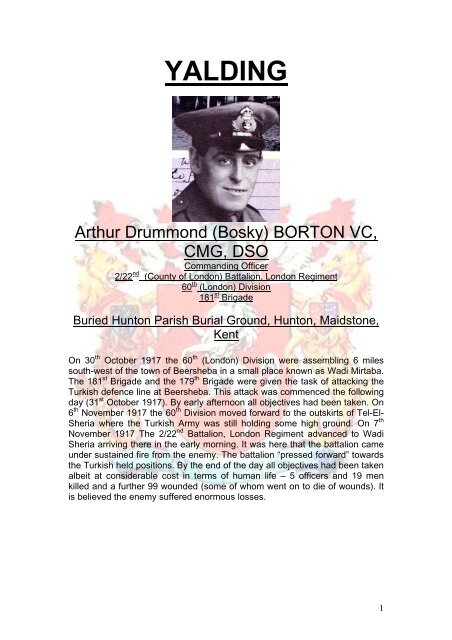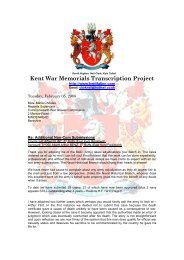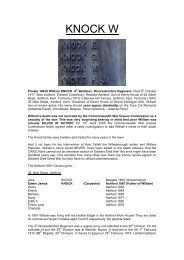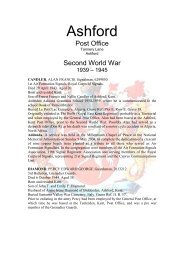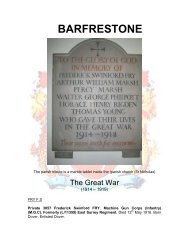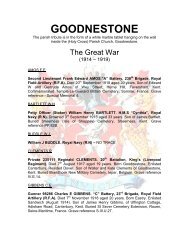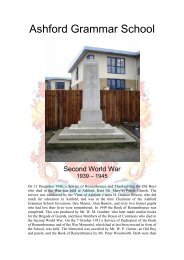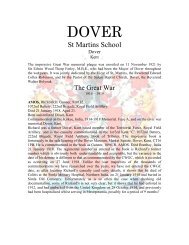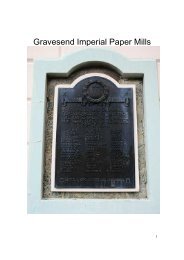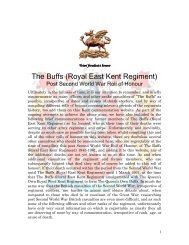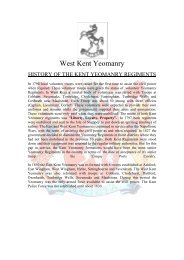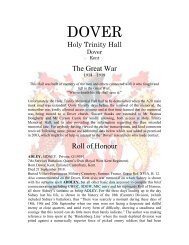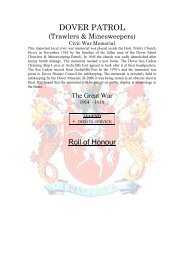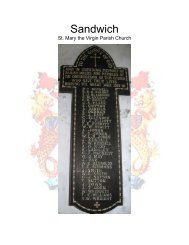Neil Raymond Clark M - Kent Fallen
Neil Raymond Clark M - Kent Fallen
Neil Raymond Clark M - Kent Fallen
You also want an ePaper? Increase the reach of your titles
YUMPU automatically turns print PDFs into web optimized ePapers that Google loves.
YALDING<br />
Arthur Drummond (Bosky) BORTON VC,<br />
CMG, DSO<br />
Commanding Officer<br />
2/22 nd (County of London) Battalion, London Regiment<br />
60 th (London) Division<br />
181 st Brigade<br />
Buried Hunton Parish Burial Ground, Hunton, Maidstone,<br />
<strong>Kent</strong><br />
On 30 th October 1917 the 60 th (London) Division were assembling 6 miles<br />
south-west of the town of Beersheba in a small place known as Wadi Mirtaba.<br />
The 181 st Brigade and the 179 th Brigade were given the task of attacking the<br />
Turkish defence line at Beersheba. This attack was commenced the following<br />
day (31 st October 1917). By early afternoon all objectives had been taken. On<br />
6 th November 1917 the 60 th Division moved forward to the outskirts of Tel-El-<br />
Sheria where the Turkish Army was still holding some high ground. On 7 th<br />
November 1917 The 2/22 nd Battalion, London Regiment advanced to Wadi<br />
Sheria arriving there in the early morning. It was here that the battalion came<br />
under sustained fire from the enemy. The battalion “pressed forward” towards<br />
the Turkish held positions. By the end of the day all objectives had been taken<br />
albeit at considerable cost in terms of human life – 5 officers and 19 men<br />
killed and a further 99 wounded (some of whom went on to die of wounds). It<br />
is believed the enemy suffered enormous losses.<br />
1
London Gazette 18 th December 1917<br />
VC Citation<br />
7 th November 1917<br />
“For most conspicuous gallantry and leadership. Under the most difficult<br />
conditions in darkness and in an unknown country, he deployed his battalion<br />
for attack, and at dawn led his attacking companies against a strongly held<br />
position. When the leading waves were checked by a withering machine gun<br />
fire, Lieutenant Colonel Borton showed an contempt of danger, and moved<br />
freely up and down his lines under heavy fire. Reorganising his command, he<br />
led his men forward, and captured the position. At a later stage of the fight he<br />
led a party of volunteers against a battery of field guns in action at point blank<br />
range, capturing the guns and detatchments. His fearless leadership was an<br />
inspiring example to the whole brigade”.<br />
Arthur Drummond (Bosky) Borton was born 1 st July 1883 at Cheveney,<br />
Yalding near Maidstone <strong>Kent</strong> (Cheveney was the family residence). Arthur<br />
was the eldest son of Colonel A.C Borton DL,JP. Educated at Eton and at the<br />
Royal Miltary Academy Sandhurst. Arthur was gazetted Second Lieutenant in<br />
the Kings Royal Rifle Corps (60 th Rifles) in 1902. He served in the last few<br />
months of the Boer War and took part in operations in the Tranvaal. On 9 th<br />
May 1906 Arthur was promoted to Lieutenant but two years later was<br />
invalided from the army unfit for further active service. Arthur returned to<br />
England in 1910 with the Queen’s South Africa Medal with 3 clasps. Arthur<br />
emigrated to the USA where he tried his hand at fruit farming.<br />
Upon the outbreak of war Arthur answered the call of his mother country and<br />
immediately returned home to Cheveney. On 22 nd October 1914 Arthur reenlisted<br />
in his old regiment the Kings Royal Rifle Corps. At some stage Arthur<br />
threw in his army commission and joined the Royal Flying Corps (RFC) as an<br />
Observer. In January 1915 Arthur left for France with No 3 Squadron RFC a<br />
Lieutenant. On 3 rd March 1915 Arthur was involved in a serious flying accident<br />
resulting in him breaking his neck in 2 places! For a second time Arthur was<br />
invalided unfit for further active service.<br />
2
Somehow Arthur then obtained a commission in the Royal Naval Volunteer<br />
Reserve! He was immediately sent to Gallipoli as a Lieutenant Commander<br />
where he commanded two squadrons of Motor Machine Gun Armoured Cars<br />
(Royal Naval Air Service). Arthur took part in the Suvla Bay landings of 7 th<br />
August 1915. It was at this stage in his military career that Arthur won his<br />
DSO.<br />
3
Distinguished Service Order (DSO)<br />
London Gazette 31 st May 1916<br />
“In recognition of most valuble services whilst in command of a detachment of<br />
Royal Marine Motor Machine Guns in difficult and dangerous parts of the line<br />
on the Gallipoli Peninsular”.<br />
Arthur remained in Gallipoli until January 1916 - he was one of the last to be<br />
evacuated to Egypt (via Mudros).<br />
In June 1916 Lieutenant Commander Arthur Drummond Borton DSO, RNVR<br />
somehow managed to obtain a commission in the army once more (Arthur<br />
was indeed a remarkable man)! Arthur was promoted Major and was<br />
appointed secon in command of the 2/22 nd London Regiment. In July 1916<br />
Athur was in France with his battalion. In November 1916 his battalion was<br />
sent to Salonika (Greece). Arthur served continuously at the front and was<br />
eventually given command of the battalion. This was without doubt the<br />
happiest time of Arthur’s life, he was absolutely elated to have been given the<br />
honour of commanding his own battalion.<br />
In June 1917 Arthur and his battalion left Salonika for Egypt. Upon arriving in<br />
Egypt the 2/22 nd London’s were rested for a short while before moving to the<br />
Palestine theatre (where Arthur was to win the VC).<br />
After the war Arthurs life was virtually downhill all the way. He was unable to<br />
hold down a job and ran up large debts. Athur started to drink heavily. It was<br />
this state of affairs that led his father to change his will. Arthur although the<br />
eldest son, was not given Cheveney the family residence. Arthur took this<br />
very badly and decided to move to 3 Park Lane, Southwold in Suffolk with his<br />
wife Lorna. They lived here on a private income. Arthur’s father died in 1927.<br />
By this time the drink had well and truly taken hold of poor Arthur. On 5 th<br />
January 1933 Arthur became ill and was taken to the cottage hospital in<br />
Southwold. At some stage he had a stroke. Athur died later that day never<br />
having regained conciousness (the drink had finally got him)!<br />
On 9 th January 1933 Arthur’s body was returned to Cheveney in <strong>Kent</strong> for<br />
burial in the Hunton parish burial ground. The army provided a guard of<br />
honour from 2 nd London Regiment who also supplied 2 buglers to sound<br />
Reville and the Last Post. Arthur’s coffin was draped in the Union flag and<br />
then placed in the grave. His headstone read –<br />
Arthur Drummond Borton VC, CMG, DSO<br />
Lieutenant Colonel 60 th Rifles<br />
2/22 nd London Regiment (The Queen’s)<br />
Son of the late Colonel A.D Borton DL, JP<br />
of Cheveney, Yalding, <strong>Kent</strong><br />
4
Headstone 1977 (still in a reasonable condition)<br />
Arthur was a truly remarkable man. He was very much of his era. A public<br />
school educated man from a posh military family. Arthur was only really happy<br />
when on active service. Never lacking in personal courage it was peacetime<br />
that seemed to give him problems….<br />
As you can see from the attached images, Arthur’s headstone is now<br />
extremely worn (2006). It has plainly been allowed to gradually deteriorate<br />
over many years.<br />
It is a national disgrace that often deceased VC men have no headstone or<br />
their headstones are decayed to the extent you can no longer read their<br />
names. We think this reflects very badly on the United Kingdom and in<br />
particular the local inhabitants where the grave lies. It is ludicrous that the<br />
worlds fourth richest country neglects it’s heros like this!<br />
The VC men are surely fine examples to our sons and daughters - NOT the<br />
badly behaved, overpayed footballers and drug-ridden half-men of the pop<br />
industry the media often seeks to falsely lionise.<br />
<strong>Neil</strong> <strong>Clark</strong> and David Hughes are attempting to raise funds for a new<br />
headstone. They want to restore his original headstone and then erect a<br />
Victoria Cross Military Pattern Portland headstone behind it. Unfortunately the<br />
Hunton parish council and local clergy are not in the slightest bit interested in<br />
helping out. The Parish Council “passes the buck” to the church and the<br />
church prefers to do nothing by citing the old nut - “it’s what the family erected<br />
and should not be interfered with”. Arthur’s old regiment (now represented by<br />
the Trustees of the Queen’s Royal Surrey Regiment Association) refuse to act<br />
independently of the vicar. What they really mean is that they all simply can’t<br />
5
e bothered! The same kind of lame excuses that we came across at Charing<br />
with Ronald Stuart VC, DSO, RD, RNR (U.S Navy Cross) LINK TO CHARING<br />
HERE.<br />
A remarkable man like Arthur deserves better than this…<br />
6
Arthur’s father Col A.D Borton<br />
7
Lorna Borton<br />
8
Arthur’s handwritten request to serve in Russia 1919<br />
10
The Rector that doesn’t care… He wrote to us stating that Arthur’s grave was<br />
merely one of many that need restoration. He didn’t seem to be interested in<br />
the fact that Arthur won the countries highest decoration for valour. According<br />
to him the headstone is an original grave marker and it shouldn’t be touched!<br />
11
November 2006<br />
12
Arthur’s headstone when we found it in 2003!<br />
Arthur’s headstone 2006 – better but still not good enough…<br />
13
November 2006<br />
The following photos are of the BORTON family’s graveyard plot in the St<br />
Mary’s (Hunton Parish) Churchyard….<br />
14
Arthur’s brother “Biffy” Borton<br />
18
“Biffy” Borton during the Second World War<br />
19
Arthur A.D Borton - A Brave man indeed…<br />
20


